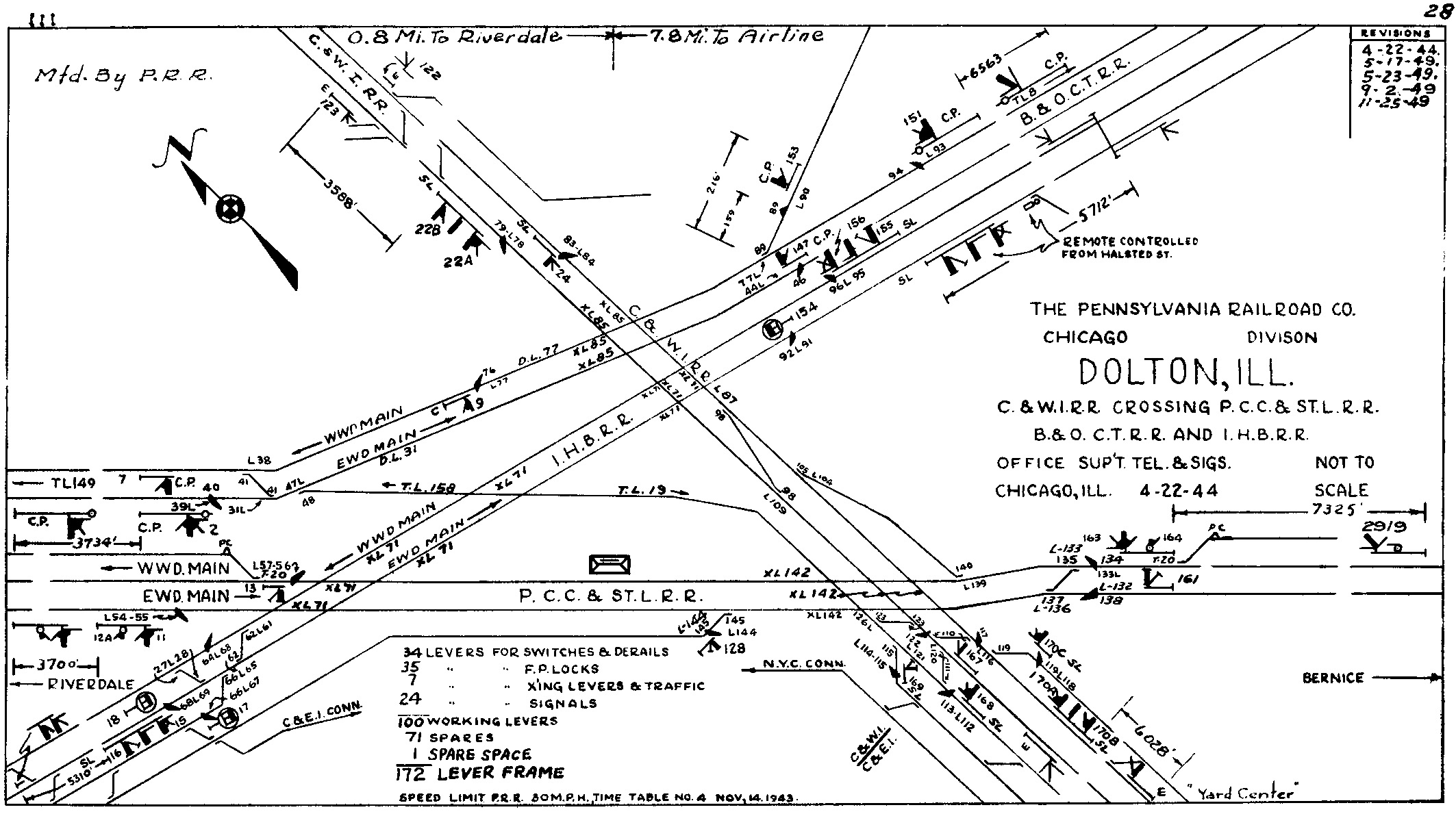The massive complex that is Dolton Junction was created by the intersection of 4 railroad main lines. The Chicago and Western Indiana railroad ran north to Dearborn St Station as a terminal line that concentrated traffic from a number of other railroads, most notably the Chicago and Eastern Illinois, which eventually wound up owned by Union Pacific. Splitting the C&WI were the parallel east-west main lines of the Indiana Harbor Belt and the Baltimore and Ohio, Chicago Terminal railroads. Finally, playing the spoiler and crossing all the of the other main lines at an angle was the Pennsylvania Railroad's "Panhandle Route" main line from Columbus Ohio. Because the PRR was involved you can find an interlocking diagram here.

The tower at Dolton Junction was built in 1897 and contained a 178 lever frame with 100 active levers. As built the interlocking contained a total of 20 diamonds which included an extra 4 from various connection tracks between the main lines. At the time most of the routes through the plant were fitted with split point derails to prevent any catastrophic Stop signal violations.
Today the interlocking plant has seen some expensive reconfigurations carried out on the old mechanical frame. With the removal of the PRR route the number of diamonds has been reduced to 11 and a few new crossovers and connector tracks have been installed. Still the interlocking is operated as an island of manual control with CTC on all sides. Most of my photos were taken from the rear of a south/eastbound train as it passed through the interlocking in 2009.
Entering Dolton Junction from the North we pass the southbound home signal which is back to back with the signals for an independent interlocking that connects the C&WI line with the B&OCT line. The Doton signals stand out as they are older searchlights and not Darth Vaders.
Next we cross the B&OCT diamonds.
Then the IHB diamonds.
And now the tower itself. I believe you can just make out some of the levers inside the open window.
Another angle....
Here we see the full interlocking from the south. From left to right we have the C&WI to B&OCT connection, the two C&WI main tracks and then the C&WI to IHB connection which was a new addition.
Moving back more we see one of the few remaining split point derails on the B&OCT connection and two H-5 model searchlights on that and the wrong direction C&WI track.
Moving back even farther we cross a grade crossing and enter UP's 144TH ST interlocking. The track to the far left does not enter Dolton Junction.
Finally we see the three-head searchlight signal for the northbound track on the south side of the grade crossing.
In 2010 Amtrak felt it wise to move the sleeping car to the head end of the train so I was forced to use the openable side window. Here is a view of Dolton Junction showing a pair of local youth trainspotters with their video equipment set up.
Previous photos taken in 2006 show the B&OCT connector track crossing the IHB main and a new diamond installed for the connector to the now defunct PRR branch that was cut back to this location. In 2012 a limited re-signaling programme was undertaken on the IHB line west of the diamonds that involved new signals and crossovers. Dolton Junction tower was not going to be closed, but I am not sure if the new interlocking plant was controlled from the tower or put under remote control.
This rear view of the tower shows the alignment of the old PRR line and in the distance a remaining PRR signal for trains coming off what is now an industrial branch.
Side view of the tower showing battery boxes and a radio repeater.
Front view of the tower showing an emergency escape ladder.
I have one interior photo made available to me from the same source as the METRA tower photos showing the impressive mechanical lever frame, model board and operator's desk. The US&S lever frame uses a horizontal locking grid situated behind the levers which results in an unusually wide tower layout. Generally mechanical locking is arranged vertically in a grid located below the levers which results in the more common tall and thin tower layout.
John Roma has a number of additional interior photos posted at:
http://www.flickr.com/photos/jonroma/se ... 973032939/
Well that's all I have for now. I might still post some pics from my 2010 trip, but they basically mirror what is already available.
For more signaling and tower photos from this photo set check out:
https://www.redoveryellow.com/position-light/09-07-25_METRA_CHICAGO_RAIL/-Thumbnails.html
Comments welcome.















No comments:
Post a Comment